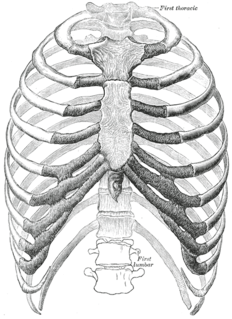
The rib cage, as an enclosure that comprises the ribs, vertebral column and sternum in the thorax of most vertebrates, protects vital organs such as the heart, lungs and great vessels.

Ophidia is a group of squamate reptiles including modern snakes and reptiles more closely related to snakes than to other living groups of lizards.
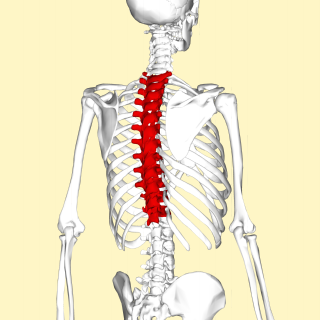
In vertebrates, thoracic vertebrae compose the middle segment of the vertebral column, between the cervical vertebrae and the lumbar vertebrae. In humans, there are twelve thoracic vertebrae and they are intermediate in size between the cervical and lumbar vertebrae; they increase in size going towards the lumbar vertebrae, with the lower ones being much larger than the upper. They are distinguished by the presence of facets on the sides of the bodies for articulation with the heads of the ribs, as well as facets on the transverse processes of all, except the eleventh and twelfth, for articulation with the tubercles of the ribs. By convention, the human thoracic vertebrae are numbered T1–T12, with the first one (T1) located closest to the skull and the others going down the spine toward the lumbar region.
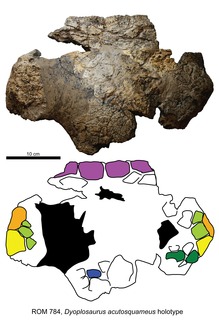
Dyoplosaurus is a monospecific genus of ankylosaurid dinosaur from Alberta that lived during the Late Cretaceous in what is now the Dinosaur Park Formation. Dyoplosaurus represents a close relative of Scolosaurus and Anodontosaurus, two ankylosaurids known from the Horseshoe Canyon and Dinosaur Park Formation.
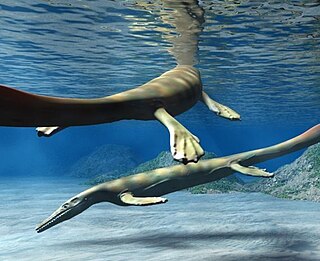
Eonatator is an extinct genus of marine lizard belonging to the mosasaur family. It is a close relative of Halisaurus, and part of the same subfamily, the Halisaurinae. It is known from the Late Cretaceous of North America, Colombia and Sweden. Originally, this taxon was included within Halisaurus, but was placed in its own genus, which also led to the subfamily Halisaurinae being created for the two genera.
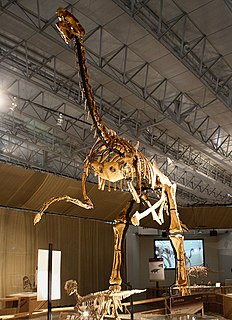
Gigantoraptor is a genus of large oviraptorosaur dinosaur that lived in Asia during the Late Cretaceous period. It is known from the Iren Dabasu Formation of Inner Mongolia, where the first remains were found in 2005.

Somphospondyli is an extinct clade of titanosauriform sauropods that lived from the Late Jurassic until the end of the Late Cretaceous, comprising all titanosauriforms more closely related to Titanosauria proper than Brachiosauridae. The remains of somphospondylans have been discovered in all six continents.
Hyposaurus is a genus of extinct marine dyrosaurid crocodyliform. Fossils have been found in Paleocene aged rocks of the Iullemmeden Basin in West Africa, Campanian–Maastrichtian Shendi Formation of Sudan and Maastrichtian through Danian strata in New Jersey, Alabama and South Carolina. Isolated teeth comparable to Hyposaurus have also been found in Thanetian strata of Virginia. It was related to Dyrosaurus. The priority of the species H. rogersii has been debated, however there is no sound basis for the recognition of more than one species from North America. The other North American species are therefore considered nomina vanum.

Qiupalong is a genus of extinct ornithomimid theropods from the Late Cretaceous of what is now China and Canada.

Ahshislepelta is a monospecific genus of ankylosaur dinosaur from New Mexico that lived during the Late Cretaceous in what is now the Hunter Wash Member of the Kirtland Formation. The type and only species, Ahshislepelta minor, is known only from an incomplete postcranial skeleton of a small subadult or adult individual. It was named in 2011 by Michael Burns and Robert M. Sullivan. Based on the size of the humerus, Ahshislepelta is larger than Pinacosaurus mephistocephalus but smaller than Talarurus and Pinacosaurus grangeri.

The vertebral column, also known as the backbone or spine, is part of the axial skeleton. The vertebral column is the defining characteristic of a vertebrate in which the notochord found in all chordates has been replaced by a segmented series of bone: vertebrae separated by intervertebral discs. Individual vertebrae are named according to their region and position, and can be used as anatomical landmarks in order to guide procedures such as lumbar punctures. The vertebral column houses the spinal canal, a cavity that encloses and protects the spinal cord.

The spinal column, characteristic of each vertebrate species, is a moderately flexible series of vertebrae, each constituting a characteristic irregular bone whose complex structure is composed primarily of bone, and secondarily of hyaline cartilage. They show variation in the proportion contributed by these two tissue types; such variations correlate on one hand with the cerebral/caudal rank, and on the other with phylogenetic differences among the vertebrate taxa.

Mauriciosaurus is a genus of polycotylid plesiosaur from the Late Cretaceous of Mexico. It contains a single species, M. fernandezi, described in 2017 by Eberhard Frey and colleagues from a single well-preserved juvenile specimen about 1.9 metres long. Morphologically, it is overall most similar to the polycotyline polycotylids Trinacromerum and Dolichorhynchops. However, several features separate Mauriciosaurus from all other polycotylids, warranting the naming of a new genus. These include the sophisticated pattern of ridges on the bottom of the parasphenoid bone on its palate; the narrow openings in the palate bordered by the pterygoid bones; the lack of perforations in the surface of the coracoid; and the highly unusual arrangement of gastralia, or belly ribs, which is only otherwise seen in the non-polycotylid Cryptoclidus.
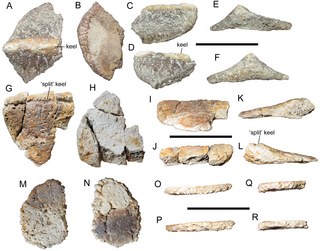
Invictarx is a monospecific genus of nodosaurid dinosaur from New Mexico that lived during the Late Cretaceous in what is now the upper Allison Member of the Menefee Formation. The type and only species, Invictarx zephyri, is known from three isolated, incomplete postcranial skeletons. It was named in 2018 by Andrew T. McDonald and Douglas G. Wolfe. Invictarx shares similarities with Glyptodontopelta from the Naashoibito member of the Ojo Alamo Formation, New Mexico.

Kamuysaurus is a genus of herbivorous edmontosaurin saurolophine hadrosaurid dinosaur from Late Cretaceous Maastrichtian marine deposits of the Yezo Group in the Hobetsu area near the town of Mukawa, Hokkaido in Japan.

Fukuipteryx is an extinct genus of basal avialan dinosaurs found in Early Cretaceous deposits from Japan's Kitadani Formation. It contains one species, Fukuipteryx prima.

Huinculsaurus is a genus of noasaurid dinosaur from the Huincul Formation in Neuquén Province, Argentina. The type and only species is Huinculsaurus montesi. It was probably around 3 metres (9.8 ft) when fully grown, although this is only speculation since no fully mature specimens are currently known.
Aphaurosuchus is an extinct genus of baurusuchid mesoeucrocodylian known from the Late Cretaceous Bauru Basin of São Paulo, southern Brazil. It contains a single species, Aphaurosuchus escharafacies.
Meemannavis is a genus of ornithuromorph bird from the Early Cretaceous (Aptian) Xiagou Formation of Gansu Province, China. The genus contains a single species, Meemannavis ductrix, known from a partial skeleton including an incomplete skull and cervical and thoracic vertebrae. The lower jaw and tip of the upper jaw of the Meemannavis holotype are toothless, but it may have had teeth nearer the back of the upper jaw.
Confractosuchus is a genus of extinct eusuchian crocodyliform from the Cretaceous Winton Formation of Australia. Described as a macro-generalist, Confractosuchus was found with the bones of a juvenile ornithopod dinosaur in its abdomen. It currently contains a single species, Confractosuchus sauroktonos, which literally means "broken dinosaur killer."































